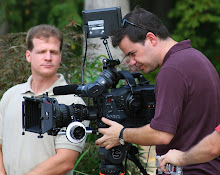Going through some old tapes in our warehouse recently, I came across a bunch of old Hi8 tapes. Remember Hi8? I sure do. In fact, it's the format that started my career. Sit back, my friends, and I'll tell you the tale. Yessir, right about near the end of the last century, oh, about nineteen hundred ninety, as I recall...
I was in the midst of my college career at the University of Maryland (go Terps!), and had recently switched from being a vocal music major (I'm not kidding about having a lovely singing voice, you know...) to RTVF, Radio Television and Film. I'm working at the RTVF Tech Center, the campus TV studio, having a blast, learning all I can about the TV engineering world. It's a fairly well-equipped facility for the time, with 1" machines, betacam decks, a Chyron Scribe, an ADO 1000, and a brand new Grass Valley 200 switcher. Two studios, one for the students to beat up on (equipped with Norelco PC-70 cameras!) and one for the "real" production work, primarily the athletic department's coaches shows.
I was getting some freelance jobs, tucking away some money, and I knew I wanted to buy a video camera for myself. But what to buy? (Cue the choir music, the footage of the clouds parting and beams of light shining through...)
Sony had just introduced a new tape format, Hi8, and the flagship model of the Hi8 line was the CCD-V5000. Full sized, shoulder mounted, VU meters on the side...hoo boy, this baby fed my naive techno-lust by the shovel full. I saved up my money, got on the waiting list (they were in very short supply at first) and eventually got the camera.
very short supply at first) and eventually got the camera.
Dave was a very happy boy. Ignorance was bliss. I didn't know what a nightmare Hi8 would end up being in terms of dropouts (Fuji eventually came up with a tape formulation that worked, but it took a couple of years), didn't know that the initial run of these cameras had backfocus problems, didn't know how limiting it would be that the camera was single-chip.
Nope, all that stuff came later. This thing was the bees knees, it looked so dang professional, and as long as there was plenty of light it really did make some fine looking pictures.
A few years later Sony came out with the UVW betacam decks, which allowed us to enter the "big leagues", format wise, and later miniDV was introduced. We used to jokingly call miniDV "Hi8 that works," since they filled the same general niche in the production world. These days it's DV50 and HD, with no-excuses gear that makes drop-dead gorgeous pictures, runs without a hitch and never complains.
But that first camera, well, I suppose it was partly the fact that it was mine, my first investment in trying to make a real go at this professional video thing. That camera was pretty special to me.
Support PixelCadabra Via Our Amazon Main Page














 ght for your organization. You'll likely get a good feel in the first couple of weeks (or days, or hours, or minutes...) and you'll know if it's going to work out. Set clear goals for the worker, and address them if they don't meet them. If they just can't seem to hit their goals after a reasonable amount of time, don't fool yourself into trying to work things out. If you have a strong feeling in your gut that the person isn't right for your company, better to get rid of them quickly and get moving on to the next person. Especially as a small business, you simply don't have the time or resources to hold someone's hand or hope for the best while they continue to flounder.
ght for your organization. You'll likely get a good feel in the first couple of weeks (or days, or hours, or minutes...) and you'll know if it's going to work out. Set clear goals for the worker, and address them if they don't meet them. If they just can't seem to hit their goals after a reasonable amount of time, don't fool yourself into trying to work things out. If you have a strong feeling in your gut that the person isn't right for your company, better to get rid of them quickly and get moving on to the next person. Especially as a small business, you simply don't have the time or resources to hold someone's hand or hope for the best while they continue to flounder.